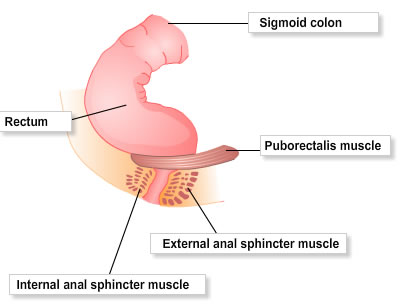
- Like the bladder the bowel is largely under autonomic control
- Emptying involves coordinated activity of the pelvic floor and anal sphincter muscles
- Faeces enters the rectum from the sigmoid colon, which stimulates the urge to defaecate via the recto-anal inhibitory reflex and the internal anal sphincter relaxes
- Valsalva’s manoeuvre increases intra-abdominal pressure
- The external anal sphincter and puborectalis muscle relax, which straightens the anorectal passage to aid bowel emptying
- Bowel emptying may be deferred by voluntary contraction of the external anal sphincter and pelvic floor puborectalis muscle, which decreases the ano-rectal angle and returns the mass to the rectum
- The internal anal sphincter relaxation reflex will fade after approximately 15 seconds and the urge to empty will resolve until triggered again
Image labels:
- Sigmoid colon
- Rectum
- Puborectalis muscle
- Internal anal sphincter muscle
- External anal sphincter muscle
Page last reviewed: 31 Jan 2022


